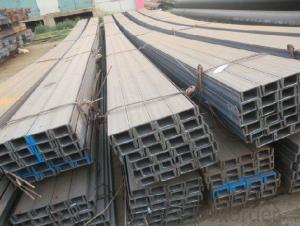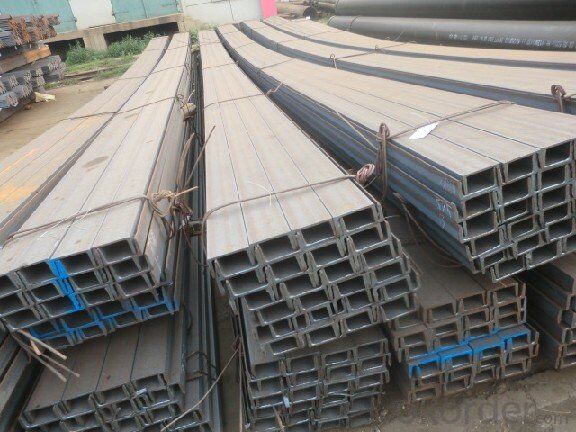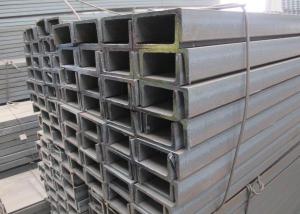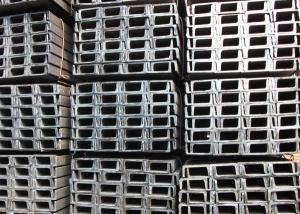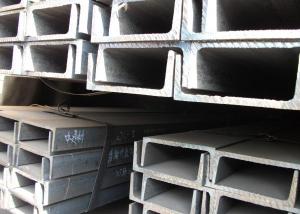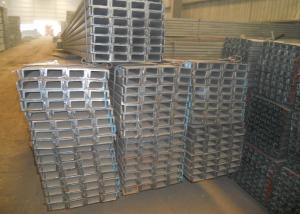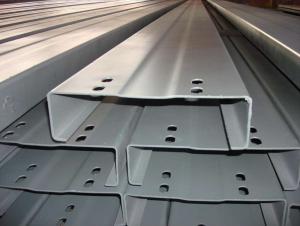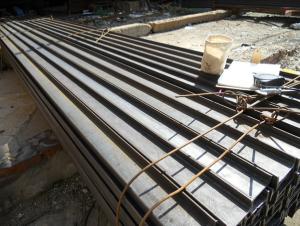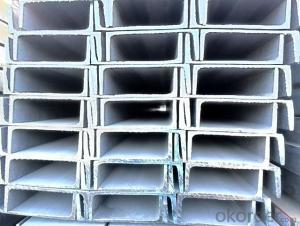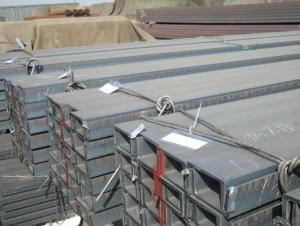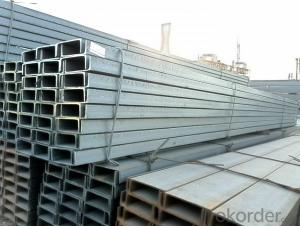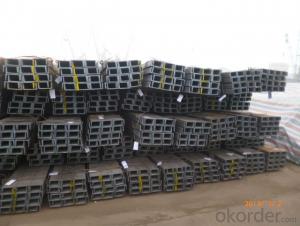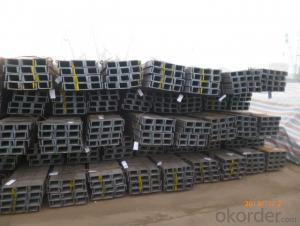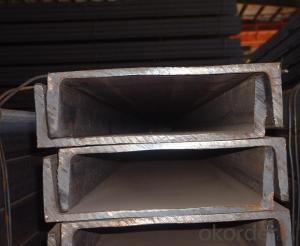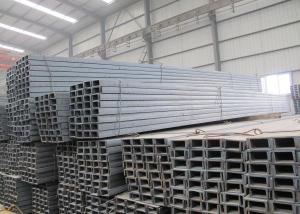Hot Rolled U-Channels with Good Quality and Best Price
- Loading Port:
- Tianjin
- Payment Terms:
- TT OR LC
- Min Order Qty:
- 25 m.t
- Supply Capability:
- 10000 m.t/month
OKorder Service Pledge
OKorder Financial Service
You Might Also Like
Specification
Okorder.com is a professional materials & equipment supplier & manufacturer, offers integrated one-stop services including real-time quoting and online cargo tracking. We are funded by CNBM Group, a Fortune 500 enterprise and the largest materials & equipment firm in China.
Product Applications:
Hot Rolled U-Channels are ideal for structural applications and are widely used in the construction of buildings and bridges, and the manufacturing, petrochemical, and transportation industries.
Product Advantages:
OKorder's U-Channels are durable, strong, and resist corrosion.
Main Product Features:
· Premium quality
· Prompt delivery & seaworthy packing (30 days after receiving deposit)
· Corrosion resistance
· Can be recycled and reused
· Mill test certification
· Professional Service
· Competitive pricing
Product Specifications:
Manufacture: Hot rolled
Grade: Q235/SS400
Certificates: ISO, SGS, BV, CIQ
Length: 6m – 12m, as per customer request
Packaging: Export packing, nude packing, bundle
JIS U CHANNEL | Standard | Sectional | Dimension |
| Mass: |
(mm) | (mm) | (mm) | (mm) | ||
50x25 | 50 | 25 | 3.0 | 6.00 | 2.37 |
75X40 | 75 | 40 | 3.8 | 7.00 | 5.30 |
75X40 | 75 | 40 | 4.0 | 7.00 | 5.60 |
75X40 | 75 | 40 | 4.5 | 7.00 | 5.85 |
75X40 | 75 | 40 | 5.0 | 7.00 | 6.92 |
100X50 | 100 | 50 | 3.8 | 6.00 | 7.30 |
100X50 | 100 | 50 | 4.2 | 6.00 | 8.03 |
100X50 | 100 | 50 | 4.5 | 7.50 | 8.97 |
100X50 | 100 | 50 | 5.0 | 7.50 | 9.36 |
125X65 | 125 | 65 | 5.2 | 6.80 | 11.66 |
125X65 | 125 | 65 | 5.3 | 6.80 | 12.17 |
125X65 | 125 | 65 | 5.5 | 8.00 | 12.91 |
125X65 | 125 | 65 | 6.0 | 8.00 | 13.40 |
150x75 | 150 | 75 | 5.5 | 7.30 | 14.66 |
150x75 | 150 | 75 | 5.7 | 10.00 | 16.71 |
150x75 | 150 | 75 | 6.0 | 10.00 | 17.90 |
150x75 | 150 | 75 | 6.5 | 10.00 | 18.60 |
150x75 | 150 | 75 | 6.5 | 10.00 | 24.00 |
200X80 | 200 | 80 | 7.5 | 11.00 | 24.60 |
The sections in details are as followings in the table-1
FAQ:
Q1: Why buy Materials & Equipment from OKorder.com?
A1: All products are carefully selected from China's most reliable manufacturing enterprises. Through its ISO certifications, OKorder.com adheres to the highest standards and a commitment to supply chain safety and customer satisfaction.We can guarantee the quality!
Q2:What's your payment terms ?
A2: We can accecpt T/T,LC at sight and time LC.
Q3: Can you supply special size ?
A3: Yes, we can produce them as per buyers' requirement and all the standard are available for us .
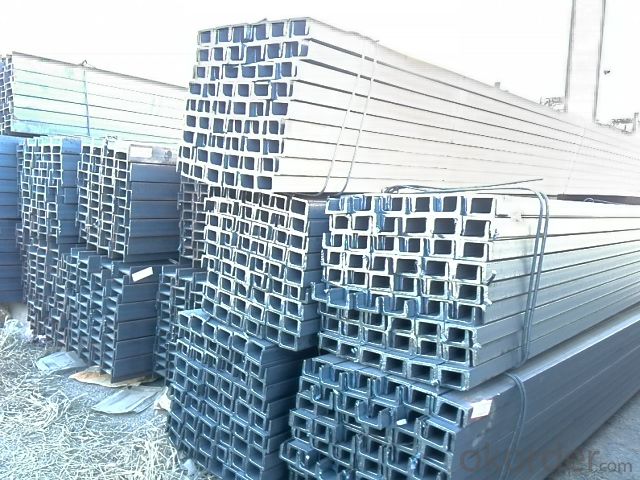
- Q: Can steel channels be used for pipe supports?
- Certainly, pipe supports can benefit greatly from the effective utilization of steel channels. With their high strength and durability, steel channels possess the perfect qualities to offer robust support to pipes. The ability to easily fabricate them into desired lengths and shapes further enhances their suitability for creating tailor-made pipe support systems. Moreover, steel channels boast exceptional load-bearing capacity, guaranteeing the stability and safety of the pipes. Their resistance to corrosion becomes particularly vital in environments featuring moisture or harsh chemicals, where the protection of pipes is paramount. Ultimately, steel channels emerge as a dependable and economically viable option for pipe supports.
- Q: What are the different methods for designing steel channels for high wind loads?
- There are several methods for designing steel channels for high wind loads. One common approach is to use the Load and Resistance Factor Design (LRFD) method, which takes into account the applied loads, such as wind pressure, and the resistance of the steel channel. Another method is the Allowable Stress Design (ASD) method, which uses a factor of safety to determine the maximum permissible stress in the steel channel. Additionally, computer-aided design (CAD) software can be utilized to analyze and optimize the structural performance of steel channels under high wind loads.
- Q: The parameters of the channel steel of Q235B
- Q235B is carbon structural steelIt consists of Q+ numeral + quality grade symbol + deoxidization method symbol. The steel dubbed "Q", representing the yield point of steel, behind the digital representation of the yield point value, in units of MPa such as Q235 (s) said the yield point for carbon steel 235 MPa. The necessary grades can be marked behind said deoxidation methods of quality grades and symbols. The quality class symbols are A, B, C, and D respectively. Deoxidation method notation: F means boiling steel; B represents semi killed steel: Z indicates calm steel; TZ stands for special sedation steel; calm steel is not marked; Z and TZ are not standard. For example, Q235-AF indicates a class of rimmed steel.
- Q: What are the different methods for protecting steel channels from chemical exposure?
- There are several methods for protecting steel channels from chemical exposure. Some common approaches include applying protective coatings such as epoxy or polyurethane, using corrosion inhibitors, employing sacrificial anodes or cathodic protection systems, and utilizing stainless steel or other corrosion-resistant alloys. Additionally, proper ventilation and regular maintenance can also help to prevent or mitigate chemical damage to steel channels.
- Q: Can steel channels be used in stadium construction?
- Yes, steel channels can be used in stadium construction.
- Q: What is the difference between hot-rolled and cold-formed steel channels?
- The main difference between hot-rolled and cold-formed steel channels lies in the manufacturing process. Hot-rolled steel channels are formed by heating the steel billet to high temperatures and then rolling it into the desired shape. This method results in a more uniform grain structure and higher strength compared to cold-formed steel channels. On the other hand, cold-formed steel channels are created by bending or rolling steel sheets at room temperature. This process is more cost-effective and allows for greater design flexibility, but the resulting channels may have a less consistent grain structure and slightly lower strength.
- Q: What calculates the endurance of a channel?
- You see the position of the connection, the size of the material and some other factor, such as: channel three directions can be put, namely: upright, upward, lying and N, which support: two ends simply supported and fixed at both ends, and the other end of the cantilever end of the cantilever, the cantilever simply supported at both ends.......
- Q: Can steel channels be used as support beams?
- Yes, steel channels can be used as support beams. Steel channels, also known as C-channels or U-channels, are commonly used in construction for their strength and structural stability. They are specifically designed to provide support and stability, making them suitable for use as support beams. Steel channels are often used in various applications such as building frames, bridges, and industrial structures, where their load-bearing capabilities are crucial. They offer high strength-to-weight ratio, durability, and resistance to bending and twisting forces, making them an ideal choice for supporting heavy loads and distributing weight effectively. Therefore, steel channels can be confidently used as support beams in various construction projects.
- Q: Can steel channels be used in mezzanine construction?
- Yes, steel channels can be used in mezzanine construction. Steel channels are commonly used as structural components in building construction due to their strength and durability. Mezzanines are intermediate floors that are constructed between the main floors of a building, providing additional space and functionality. Steel channels can be used as beams or columns in mezzanine construction to provide support and stability to the structure. They can be easily fabricated and installed, making them an ideal choice for mezzanine construction projects. Additionally, steel channels can be customized to meet specific design requirements and can be combined with other steel components, such as steel plates and angles, to create a robust and reliable mezzanine structure.
- Q: Can steel channels be used for creating curved or angled sections?
- Yes, steel channels can be used for creating curved or angled sections. Steel channels are versatile structural components that can be manipulated to form various shapes and angles. They can be bent or curved using specialized machinery or techniques such as cold bending or rolling. By heating the steel channel to a specific temperature, it can be easily curved or bent to the desired angle. Additionally, steel channels can also be cut at an angle to create angled sections. These curved or angled sections can be used in a wide range of applications, including architectural designs, construction projects, and industrial equipment.
Send your message to us
Hot Rolled U-Channels with Good Quality and Best Price
- Loading Port:
- Tianjin
- Payment Terms:
- TT OR LC
- Min Order Qty:
- 25 m.t
- Supply Capability:
- 10000 m.t/month
OKorder Service Pledge
OKorder Financial Service
Similar products
Hot products
Hot Searches
Related keywords
